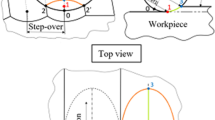Abstract
Since productivity and product quality are always regarded as important issues in manufacturing technologies, a reliable method for predicting machining errors is essential to meeting these two conflicting requirements. However, the conventional roughness model is not suitable for the evaluation of machining errors for highly efficient machining conditions. Therefore, a different approach is needed for a more accurate calculation of machining errors. This study deals with the geometrical surface roughness in ball-end milling. In this work, a new method, called the ridge method, is proposed for the prediction of the machined surface roughness in the ball-end milling process. In Part I of this two-part paper, a theoretical analysis for the prediction of the characteristic lines of the cut remainder are generated from a surface generation mechanism of a ball-end milling process, and three types of ridges are defined. The trochoidal trajectories of cutting edges are considered in the evaluation of the cut remainder. The predicted results are compared with the results of a conventional roughness model.
Similar content being viewed by others
References
Smith S, Tlusty J (1991) An overview of modeling and simulation of milling process. ASME J Eng Ind 113(2):169–175
Tlusty J (1978) Analysis of state of research in cutting dynamics. Ann CIRP 27(2):583–589
Zhang GM, Kapper SG (1991) Dynamics generation of machined surfaces, Part 1: Description of a random excitation system. ASME J Eng Ind 113(2):137–144
Schulz H (1991) High-speed milling of dies and moulds – cutting conditions and technology. Ann CIRP 44(1):35–38
Shatla M, Altan T (2000) Analytical modeling of drilling and ball end milling. J Mater Process Technol 98(1):125–133
Yang MY, Park HD (1991) The prediction of cutting force in ball-end milling. Int J Mach Tools Manuf 31(1):45–54
Feng HY, Menq CH (1994) The prediction of cutting forces in ball-end milling process. I: Model formulation and model building process. Int J Mach Tools Manuf 34(4):697–710
Feng HY, Menq CH (1994) The prediction of cutting forces in ball-end milling process. II: Cut geometry analysis and model verification. Int J Mach Tools Manuf 34(4):711–720
Lazoglu I, Liang SY (1997) An improved analytic modeling of force system in ball-end milling. Manuf Sci Eng 2:135–141. Also in: Proceedings of the 1997 ASME international mechanical engineering congress and exposition, Dallas, 12–16 November 1997
Feng HY, Menq CH (1996) A flexible ball-end milling system model for cutting force and machining error prediction. ASME J Manuf Sci Eng 118(3):461–469
Ikua BW, Tanaka H, Obata F, Sakamoto S, Kishi T, Ishii T (2001) Prediction of cutting forces and machining error in ball end milling of curved surface. I: Theoretical analysis. J Int Soc Precis Eng Nanotechnol 25(3):266–273
Ikua BW, Tanaka H, Obata F, Sakamoto S, Kishi T, Ishii T (2002) Prediction of cutting forces and machining error in ball end milling of curved surface. II: Experimental verification. J Int Soc Precis Eng Nanotechnol 26(1):69–82
Kanata H, Obata F, Ikua BW, Sakamoto S, Ashimori M (1999) Cutting forces and machining error in ball end milling of inclined flat surfaces. Int J Jpn Soc Precis Eng 33(3):319–325
Loney GC, Ozsoy TM (1987) NC machining of free form surfaces. Comput Aided Des 19(2):85–90
Vickers GW, Quan KW (1989) Ball-mills versus end-mills for curved surface machining. ASME J Eng Ind 111(2):22–26
Choi BK, Jerard RB (1998) Scupltured surface machining – theory and applications. Kluwer, Dordrecht
Miyazawa S, Takada K (1981) Micro milling of three-dimensional surface. J Jpn Soc Precis Eng 47(2):94–99 [in Japanese]
Naito K, Ogo K, Konaga T, Abe T, Kanda K, Matusouka K (1994) Development of ball end milling for fine high-efficiency finishing. Int J Jpn Soc Precis Eng 28(2):105–110
Kim BH, Chu CN (1994) Effect of cutter mark on surface roughness and scallop height in sculptured surface machining. Comput Aided Des 26(3):179–188
Kim BH, Chu CN (1999) Texture prediction of milled surface using texture superposition method. Comput Aided Des 31(3):485–484
Koreta N, Egawa T, Kuroda M, Watanabe K, Ii Y (1993) Analysis of surface roughness generation by ball end mill machining. J Jpn Soc Precis Eng 59(9):129–134 [in Japanese]
Author information
Authors and Affiliations
Corresponding author
Rights and permissions
About this article
Cite this article
Jung, TS., Yang, MY. & Lee, KJ. A new approach to analysing machined surfaces by ball-end milling, part I:. Int J Adv Manuf Technol 25, 833–840 (2005). https://doi.org/10.1007/s00170-003-1930-5
Received:
Accepted:
Published:
Issue Date:
DOI: https://doi.org/10.1007/s00170-003-1930-5




